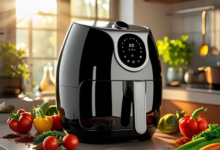The Green Kitchen Revolution: How Air Fryers Are Changing Our Environmental Impact

In an era where every purchase decision carries environmental weight, you might wonder: Is buying an air fryer good or bad for the planet? With climate change concerns growing and sustainability becoming a household priority, it’s a fair question that deserves a thorough, honest answer.
The environmental story of air fryers is more complex than simple marketing claims suggest. According to research data compiled by best-air-fryer.co.uk, which analyzes over 1,800 models from 400+ brands, the environmental impact varies significantly based on how, where, and how often these appliances are used.
But here’s what’s fascinating: air fryers might actually represent one of the most environmentally positive kitchen appliance trends in recent years – if you understand how to maximize their eco-friendly potential while avoiding the sustainability pitfalls that many usxers fall into.
Let’s explore the real environmental impact of air fryers and discover how to make your crispy cooking habits as green as possible.
The Energy Efficiency Reality Check
Let’s start with the most obvious environmental consideration: how much energy air fryers actually consume compared to alternatives.
Energy Consumption Basics
Most air fryers use between 1200-1500 watts during operation. This might sound like a lot, but context is everything. A typical electric oven uses 2500-5000 watts, while gas ovens have their own environmental considerations through fossil fuel consumption.
Real-World Energy Calculations
For a typical 30-minute cooking session, an air fryer uses approximately 0.6-0.75 kWh of electricity. Compare this to a conventional oven using 1.25-2.5 kWh for the same cooking time, and the energy savings become significant – typically 50-75% less energy consumption.
The Preheating Factor
Perhaps more importantly, air fryers eliminate the energy waste of preheating large oven cavities. A conventional oven might use 1-2 kWh just for preheating, while air fryers are ready to cook in 2-3 minutes with minimal energy expenditure.
Annual Energy Impact
For a household using an air fryer 4 times per week instead of their conventional oven, the annual energy savings typically range from 200-400 kWh. Depending on your local energy source, this could prevent 100-300 pounds of CO2 emissions annually.
Manufacturing and Carbon Footprint Analysis
The environmental impact starts long before you plug in your air fryer.
Materials and Manufacturing
Air fryers require steel, aluminum, plastic, and electronic components. The manufacturing process involves mining, refining, molding, and assembly – all energy-intensive processes. However, their relatively simple construction and smaller size compared to full ovens means lower overall material requirements.
Global Supply Chain Considerations
Most air fryers are manufactured in Asia and shipped globally, contributing to transportation emissions. However, their compact size allows for efficient shipping – multiple units can fit in the space required for one conventional oven.
Manufacturing Efficiency Trends
As air fryer production has scaled up dramatically over the past five years, manufacturing efficiency has improved. Larger production runs mean lower per-unit environmental costs, and competition has driven improvements in energy-efficient manufacturing processes.
Carbon Payback Period
For most users, the energy savings from air fryer use offset the manufacturing carbon footprint within 6-18 months of regular use, assuming the air fryer replaces higher-energy cooking methods.
Packaging and Shipping Environmental Costs
The journey from factory to your kitchen has its own environmental implications.
Packaging Materials
Air fryers typically come in cardboard boxes with foam or molded pulp inserts. While this creates waste, the packaging is generally recyclable and necessary for protecting the appliance during shipping.
Shipping Efficiency
The compact size of air fryers allows for efficient shipping. Standard shipping containers can hold significantly more air fryers than traditional ovens, reducing the per-unit transportation footprint.
Local vs. Global Purchasing
Buying from local retailers doesn’t necessarily reduce environmental impact if the product still originated overseas. However, it can reduce final-mile delivery emissions if you pick up the appliance rather than having it delivered.
Packaging Waste Reduction
Some manufacturers are moving toward more sustainable packaging, using recycled materials and reducing unnecessary packaging components. Look for brands that prioritize environmental packaging when making purchasing decisions.
Food Waste Reduction Potential
This might be air fryers’ biggest environmental benefit – their potential to reduce food waste.
Portion Control Benefits
Air fryers excel at cooking small portions perfectly. This encourages cooking exactly what you need rather than making large batches that might go to waste. Food waste is responsible for roughly 8% of global greenhouse gas emissions, so any reduction is environmentally significant.
Leftover Revival
Air fryers are exceptional at reviving leftovers, particularly foods that become soggy when microwaved. This can extend the life of cooked foods and reduce waste from meals that would otherwise be discarded.
Encouraging Home Cooking
By making cooking more convenient and results more predictable, air fryers can encourage more home cooking and less reliance on takeout and restaurant meals, which typically have higher environmental footprints due to packaging and transportation.
Single-Serving Efficiency
For single-person households or when family members eat at different times, air fryers allow efficient cooking of individual portions without the energy waste of heating large ovens for small amounts of food.
Oil Consumption and Environmental Impact
The oil story has multiple environmental angles worth considering.
Reduced Oil Consumption
Traditional deep frying can use 1-2 liters of oil for a single cooking session. Air frying typically requires just a teaspoon or tablespoon of oil. This dramatic reduction means less agricultural land devoted to oil production and less processing required.
Oil Production Environmental Costs
Most cooking oils require significant water, land, and processing energy to produce. Palm oil, in particular, has been linked to deforestation. By dramatically reducing oil consumption, air frying indirectly reduces pressure on these agricultural systems.
Oil Disposal Benefits
Used cooking oil disposal is an environmental challenge. Large quantities from deep frying often end up in landfills or inappropriately disposed of, potentially contaminating water systems. Air frying’s minimal oil use largely eliminates this disposal problem.
Quality Oil Usage
Because air frying requires so little oil, users can afford higher-quality, more sustainably produced oils without significant cost increases, potentially supporting more environmentally responsible agricultural practices.
Comparing Air Fryers to Other Cooking Methods
To understand the environmental impact, we need to compare air fryers to realistic alternatives.
Air Fryer vs. Conventional Oven
Energy savings of 50-75% make this comparison favorable for air fryers, especially for small batches. However, for large family meals, a conventional oven might be more efficient per serving.
Air Fryer vs. Stovetop Cooking
Electric stovetops are generally efficient for direct heating, but air fryers can be more efficient for foods requiring contained heat and air circulation. Gas stovetops have fossil fuel implications but can be efficient for some cooking methods.
Air Fryer vs. Microwave
Microwaves use less energy overall but can’t achieve the same food textures. For reheating, microwaves are more efficient. For cooking from scratch, air fryers offer better results with moderate energy increases.
Air Fryer vs. Deep Fryer
Beyond energy considerations, air fryers eliminate the oil production and disposal environmental costs associated with deep frying, making them significantly more environmentally friendly overall.
Lifespan and Durability Considerations
The environmental impact depends heavily on how long your air fryer lasts.
Average Lifespan Expectations
Quality air fryers typically last 3-5 years with regular use, while budget models might last 1-3 years. This is shorter than conventional ovens (15-20 years) but comparable to other small appliances.
Factors Affecting Lifespan
- Build quality and materials used
- Frequency and intensity of use
- Maintenance and cleaning habits
- Electrical stability in your home
Maximizing Environmental Value
To maximize environmental benefits, choose quality models that will last longer, maintain them properly, and use them frequently enough to justify their manufacturing footprint.
Repair vs. Replace Considerations
Most air fryers aren’t economically repairable due to their integrated design and relatively low cost. This means choosing durable models initially is crucial for environmental impact.
End-of-Life Disposal and Recycling
What happens to your air fryer when it dies matters for its overall environmental impact.
Electronic Waste Considerations
Air fryers contain electronic components that require proper e-waste recycling. Simply throwing them in regular trash sends potentially recoverable materials to landfills and may release harmful substances.
Material Recovery Potential
The metal components (steel, aluminum) in air fryers are highly recyclable and valuable. The plastic components are more challenging but often recyclable through specialized programs.
Proper Disposal Methods
- Electronic recycling centers that accept small appliances
- Manufacturer take-back programs offered by some brands
- Retailer recycling programs when purchasing replacements
- Municipal e-waste collection events
Preparation for Disposal
Before disposal, remove all food residues, separate removable parts if possible, and check if any components can be reused or repurposed.
Supporting Sustainable Food Choices
Air fryers can support more sustainable eating patterns in several ways.
Encouraging Vegetable Consumption
Air fryers excel at making vegetables delicious and crispy, potentially encouraging higher vegetable consumption. Plant-based diets generally have lower environmental footprints than meat-heavy diets.
Reducing Processed Food Dependence
By making it easy to prepare fresh foods with satisfying textures, air fryers can reduce reliance on heavily processed, packaged foods that have higher environmental costs due to processing and packaging.
Supporting Local and Seasonal Eating
Air fryers make it easy to prepare whatever fresh, local ingredients are available, supporting more seasonal eating patterns that typically have lower environmental impacts.
Meal Prep Efficiency
Air fryers facilitate efficient meal preparation, which can reduce food waste and support more intentional, sustainable eating habits.
Water Usage and Conservation Benefits
Water consumption might not be obvious, but it’s part of the environmental equation.
Minimal Water Requirements
Air fryers require almost no water for operation, unlike steaming methods or cooking methods requiring large pots of water to be heated.
Cleaning Water Efficiency
The non-stick surfaces of most air fryer baskets require minimal water and soap for cleaning compared to large pots, pans, and oven cleaning.
Indirect Water Savings
By reducing oil consumption, air fryers indirectly reduce the water requirements for oil crop irrigation and processing, which can be substantial for crops like palm oil.
Dishwasher Efficiency
Most air fryer components are dishwasher-safe, and their compact size means they don’t significantly impact dishwasher efficiency when cleaning is needed.
Indoor Air Quality and Health Environment
Environmental health includes your home’s air quality, where air fryers can have positive impacts.
Reduced Cooking Smoke
Air frying typically produces less smoke and airborne grease than traditional frying methods, improving indoor air quality and reducing the need for ventilation energy.
Eliminating Deep Frying Vapors
Deep frying releases significant airborne oils and potentially harmful compounds. Air frying largely eliminates these indoor air quality concerns.
Energy-Efficient Ventilation
Because air fryers produce less smoke and odor, they may require less kitchen ventilation, reducing the energy costs of exhaust fans and air filtration.
Reduced Cleaning Chemical Use
Less airborne grease means less buildup on kitchen surfaces, potentially reducing the need for cleaning chemicals and their associated environmental impacts.
Economic Sustainability for Households
Environmental sustainability and economic sustainability often go hand in hand.
Energy Cost Savings
The 50-75% energy reduction compared to conventional ovens translates to real money savings over time, typically $20-60 annually for regular users.
Oil Cost Reduction
Dramatic reductions in cooking oil usage can save households $50-200 annually, depending on previous cooking habits.
Food Waste Cost Savings
Reducing food waste through better portion control and leftover revival can save significant money while benefiting the environment.
Health Cost Considerations
Healthier cooking methods may contribute to reduced healthcare costs over time, though this is difficult to quantify directly.
Maximizing Your Air Fryer’s Green Potential
Here’s how to ensure your air fryer use is as environmentally friendly as possible.
Optimal Usage Patterns
- Use frequently to justify the manufacturing footprint
- Cook appropriate portions to maximize energy efficiency
- Batch cook when possible to reduce overall energy use
- Replace higher-energy cooking methods rather than adding to them
Maintenance for Longevity
- Clean thoroughly after each use to prevent component degradation
- Follow manufacturer guidelines for care and maintenance
- Address problems early to prevent complete failure
- Store properly when not in use
Sustainable Purchasing Decisions
- Choose quality models that will last longer
- Consider energy efficiency ratings when available
- Buy from companies with environmental commitments
- Avoid frequent upgrading unless necessary
End-of-Life Planning
- Plan for proper disposal from the beginning
- Research recycling options in your area
- Consider donation if the unit still works when you upgrade
- Remove all personal food residues before disposal
The Future of Sustainable Kitchen Technology
Air fryers represent just one step in the evolution toward more sustainable kitchen appliances.
Emerging Efficiency Technologies
Future air fryers may incorporate more efficient heating elements, better insulation, and smart controls that optimize energy use based on food type and quantity.
Sustainable Material Innovations
Manufacturers are exploring more sustainable materials, including recycled plastics, bio-based components, and more easily recyclable designs.
Integration with Renewable Energy
As home solar and other renewable energy sources become more common, the environmental benefits of efficient electric appliances like air fryers will increase.
Smart Technology Integration
Future models may include smart features that optimize cooking efficiency, suggest sustainable cooking practices, and integrate with home energy management systems.
Your Kitchen’s Environmental Impact Is In Your Hands
The environmental story of air fryers is ultimately positive when they’re used thoughtfully to replace less efficient cooking methods and support sustainable eating habits. They’re not perfect – no appliance is – but they represent a step toward more efficient, lower-impact cooking technology.
The key to maximizing environmental benefits lies in how you integrate air frying into your overall cooking and eating patterns. Use your air fryer frequently, maintain it well, cook appropriate portions, and let it help you waste less food and energy.
Remember, the most sustainable appliance is one that helps you cook more efficiently, waste less food, and enjoy healthier eating patterns over many years of use. When an air fryer accomplishes these goals, its environmental benefits extend far beyond simple energy calculations.
The green kitchen revolution isn’t just about buying the right appliances – it’s about using them wisely to create more sustainable, enjoyable, and efficient cooking habits that benefit both your family and the planet.
Ready to make your air frying as green as it is delicious? Your planet will thank you for every mindful choice you make in the kitchen!
Read Also: www.eyexconcom





